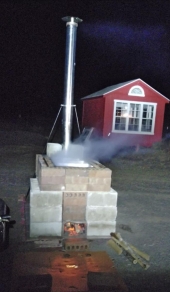
 3
3








I make a Maple Syrup instructional movie! Check it out HERE
SKIP books, get 'em while they're hot!!! Skills to Inherit Property
See me in a movie building a massive wood staircase:Low Tech Lab Movie









Hans Albert Quistorff, LMT projects on permies Hans Massage Qberry Farm magnet therapy gmail hquistorff




Life is an interview. Don't blow it!








Walt Chase wrote:I would think you would want the flames/ most intense heat licking the bottom of the pans. Do you have any experience with commercial sap evaporators? If not, I would look at the oil or propane fired ones and see how they are built for boiling with flat bottom pans. The closer you are without inhibiting the draft/flow of the flames/heat the better I would think.
Stew Haggerty wrote: My only suggestion would be to make your surface area as large as you can. I also use 3 hotel pans but have made a cinder block stove, not a rocket. I love the idea of using a rocket and I looked at your idea from last year about the double rocket which could be a game changer. You could probably triple your output by using the 2 outside surfaces as boilers and the middle as a warmer.
I do plan to use a fiberglass rope under the surface to make a tighter seal. Last year the pans were a very loose fit its not a huge issue the flames don't try to escape. but some heat is surely lost and I think cold air is actually sucked in as the flames create a venturi effect. so the tighter it is the more efficient it should be. I had not seen this Walker cookstove but thats pretty cool. I was originally thinking of a serpentine path like this but I think with a pan this narrow it wont be really necessary.Hans Quistorff wrote: do you plan to set the steel plate/evaporator pans on fiberglas rope to seal in the flame and allow for expansion.








Walt Chase wrote:Have you looked at using a "commercial" small flat pan? .

|
You showed up just in time for the waffles! And this tiny ad:
The new kickstarter is now live!
https://www.kickstarter.com/projects/paulwheaton/garden-cards
|






